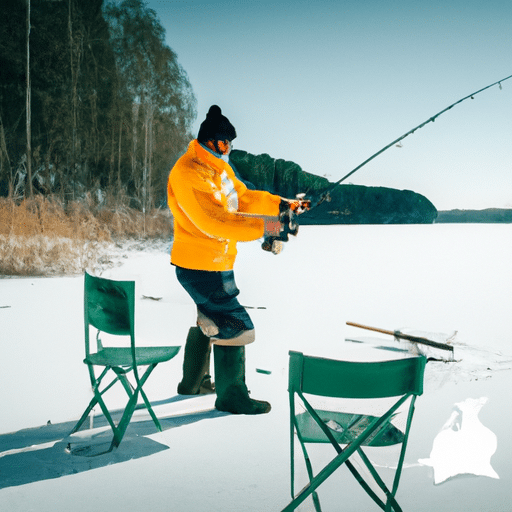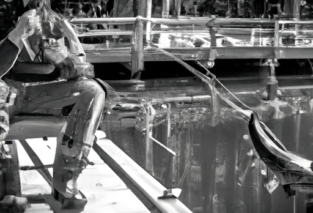Imagine being able to enjoy the peacefulness of fishing even during the cold winter months. If you’ve ever wondered whether it’s possible to go fishing in cold weather, we have great news for you! Introducing “Can You Go Fishing in Cold Weather: Tips and Techniques for Winter Angling,” your ultimate guide to conquering the chilly waters. Packed with expert advice and practical tips, this indispensable resource will show you how to make the most of your winter angling adventures. From choosing the right gear to mastering specialized techniques, get ready to embrace the joy of fishing all year round. So why wait? Let’s dive into the world of winter fishing and catch those prized cold-weather fish!

Choosing the Right Location
Water Temperature
When it comes to fishing in cold weather, the water temperature plays a crucial role in determining the success of your fishing trip. Fish tend to become more sluggish in colder temperatures, so it’s important to choose a location where the water is not too frigid. Look for areas with slightly warmer water, such as near a warmwater discharge from a power plant or areas with shallow depths that can retain heat from the sun. These areas can attract fish seeking warmer temperatures and increase your chances of a successful catch.
Fish Behavior in Cold Weather
Understanding fish behavior in cold weather is key to having a productive fishing experience. As the water temperature drops, fish tend to move slower and seek refuge in deeper waters or near structures that provide cover. They become more lethargic and their feeding patterns change. It’s important to adjust your fishing techniques accordingly, using slower retrieves and smaller lures to entice the fish. Familiarize yourself with the behavior patterns of the specific fish species you’re targeting to increase your chances of a successful catch.
Ice Fishing
One popular method of cold weather fishing is ice fishing. This exhilarating activity involves drilling a hole in the ice and dropping your line through it to catch fish below. Ice fishing requires careful planning and preparation to ensure safety. It’s crucial to check the thickness of the ice before venturing out onto it. Generally, at least four inches of clear, solid ice is considered safe for walking, while six to eight inches is necessary for snowmobiles or ATVs. Additionally, it’s important to have the right equipment, such as an ice auger, an ice fishing rod and reel, and ice fishing shelters to protect you from the elements.
Cold Weather Fishing Gear
Layering Clothing
Staying warm and comfortable is essential when fishing in cold weather. Layering your clothing is one of the most effective ways to combat the low temperatures. Start with a moisture-wicking base layer to keep sweat away from your skin. Add a insulating mid-layer to provide warmth, such as a fleece or down jacket. Finally, top it off with a waterproof and windproof outer layer to protect against the elements. Don’t forget to wear a hat and gloves to keep your extremities warm. Remember, it’s better to overdress and remove layers if needed than to underdress and risk hypothermia.
Insulated Boots and Gloves
Keeping your feet and hands warm is crucial when spending long hours fishing in cold weather. Insulated boots are designed to keep your feet dry and warm, and often come with additional features such as waterproof materials and non-slip soles for added traction on icy surfaces. Insulated gloves or mittens are also essential to protect your hands from the cold. Look for gloves with features like insulation, waterproofing, and dexterity for handling your fishing gear. It’s also a good idea to have an extra pair of gloves or mittens in case the ones you’re wearing become wet.
Fishing Shelters
If you plan on ice fishing, investing in a fishing shelter is highly recommended. A fishing shelter provides protection from wind, snow, and freezing temperatures, allowing you to fish in comfort. There are various types of fishing shelters available, including flip-over shelters, hub-style shelters, and permanent ice houses. Consider your specific needs and preferences when choosing a shelter. Ensure that it is easy to set up, provides adequate insulation, and has enough space to accommodate you and your fishing gear.

Preparing Your Fishing Equipment
Inspecting Your Rod and Reel
Before heading out to fish in cold weather, it’s important to thoroughly inspect your fishing equipment. Check your rod and reel for any signs of damage or wear. Look for cracks, loose or damaged guides, and reel malfunctions. It’s crucial that your equipment is in good working condition to avoid any mishaps on the water. Replace any damaged parts or consider getting a professional tune-up if necessary. Taking the time to inspect and maintain your gear will ensure that it performs optimally and increases your chances of a successful fishing experience.
Choosing the Right Line
Selecting the appropriate fishing line for cold weather fishing is essential. In colder temperatures, fish tend to be less active, and their bites can be subtle. Opt for a low-stretch monofilament or fluorocarbon line, as these lines offer better sensitivity and allow you to detect even the slightest bites. Additionally, consider using a thinner diameter line to increase sensitivity and decrease resistance in the water. Be sure to spool your reel with fresh line before heading out to fish, as older lines may become brittle and prone to breaking in colder temperatures.
Tuning Your Lures
Cold water affects the behavior of fish, making them less likely to chase fast-moving lures. To increase your chances of enticing a bite, it’s important to tune your lures appropriately. Check the hooks on your lures to ensure they’re sharp and in good condition. Dull hooks can result in missed opportunities to hook a fish. Consider downsizing your lures and using slower presentations to target inactive fish. Adjust your retrieve speed to match the sluggishness of the fish and experiment with different techniques to find what works best in the cold water.
Understanding Cold Water Fishing
Slow and Steady Retrieval
In cold water, fish become less active and sluggish. As a result, it’s important to adapt your retrieval techniques accordingly. Switch to a slower, more methodical retrieve to mimic the natural movement of prey in cold water. A slow and steady retrieval allows fish more time to assess and strike your bait, increasing your chances of a successful catch. Experiment with different retrieval speeds and techniques to find what triggers the fish to bite.
Depth and Structure
Fish instinctively seek refuge in deeper waters and near structures during cold weather. Understanding the depth and structure of the water you’re fishing in can greatly improve your chances of finding fish. Use a depth finder or fish finder to locate areas with varying depths and potential underwater structures such as submerged logs, rock formations, or drop-offs. These spots serve as hiding places for fish and increase your chances of a successful catch. Adjust your fishing techniques accordingly by targeting these areas with slower presentations and smaller lures.
Using Smaller Lures
In cold water, fish tend to have a more selective feeding behavior and may be less willing to expend energy on larger prey. As such, downsizing your lures can greatly improve your chances of attracting fish. Switch to smaller, more realistic lures that closely resemble the natural prey of the fish you’re targeting. Consider using finesse baits, such as small jigs or soft plastics, to entice bites from inactive fish. Matching the size and color of your lures to the prevailing conditions can make a significant difference in your cold weather fishing success.

Techniques for Winter Angling
Jigging
Jigging is a popular technique used in cold weather fishing that involves rhythmic movements of the rod to simulate the natural motion of prey. To jig effectively, lower your lure to the desired depth, raise it with a quick upward motion, and allow it to fall back with a controlled drop. Repeat this motion to entice fish into biting. Vary the speed and intensity of your jigging to trigger the fish’s predatory instincts. Jigging can be done with various types of lures, such as spoons, jigs, or soft plastics. Experiment with different colors, sizes, and jigging patterns to find what works best for the fish you’re targeting.
Deadsticking
Deadsticking is a technique that involves suspending a baited hook or lure in the water and allowing it to remain stationary. This technique works well in cold weather conditions when fish become less active and may not be willing to chase after moving lures. To deadstick, select a bait or lure that remains buoyant or slowly sinks and cast it out to your desired location. Allow the bait to sit in the water column without any movement. Patience is key when deadsticking, as it may take some time for the fish to notice and strike your bait. Monitor your line for any signs of movement or a subtle bite and be ready to set the hook.
Tip-Ups
Tip-ups are mechanical devices that allow you to fish multiple holes simultaneously. They consist of a spool attached to a flag that pops up when a fish takes the bait. Using tip-ups can greatly increase your chances of catching fish in cold weather, as they increase your coverage area and allow you to fish effectively in more than one hole at a time. Bait the hooks on your tip-ups with live or artificial bait and set them up in strategic locations. Monitor the flags closely, as they will indicate when a fish has taken the bait. When a flag is raised, approach the tip-up calmly and carefully to avoid spooking the fish. Engage the spool and reel in your catch.
Finding Success in Cold Weather
Patience and Persistence
Cold weather fishing requires patience and persistence. Fish become less active in colder temperatures and may not be as willing to bite. It’s important to remain patient and maintain a positive mindset even if you don’t get immediate results. Stay focused and committed to your fishing techniques, and be prepared to invest more time into each fishing hole. Remember, the key to success in cold weather fishing is perseverance. Keep trying different spots, techniques, and lures until you find what works best for the fish you’re targeting.
Matching the Hatch
In cold weather, it’s important to pay attention to the natural prey available to the fish you’re targeting. Observe the water and look for signs of small insects, baitfish, or other organisms that fish feed on. Match the size, color, and action of your lures to closely resemble the natural prey present in the water. Choosing the right bait that mimics the prevailing food sources can greatly increase your chances of attracting bites from fish. Consider carrying a variety of lures in your tackle box to adapt to changing conditions and better imitate the hatch.
Observing Weather Conditions
Monitoring and understanding weather conditions is crucial for successful fishing in cold weather. Pay attention to factors such as air temperature, wind direction and speed, cloud cover, and barometric pressure. Cold fronts, for example, can significantly affect fish behavior and feeding patterns. As a general rule, fish tend to be more active before a cold front arrives and become less active during and after the front passes. Adjust your fishing strategies accordingly by targeting feeding windows and focusing on areas with favorable wind conditions. Understanding how weather conditions impact fish behavior will give you an edge when fishing in cold weather.

Safety Measures for Cold Weather Fishing
Checking Ice Thickness
Safety should always be a top priority when fishing in cold weather, especially when ice fishing. Before venturing out onto the ice, it’s essential to check the thickness and quality of the ice. At least four inches of clear, solid ice is considered safe for walking, while six to eight inches is necessary for snowmobiles or ATVs. Drill test holes at regular intervals to measure the thickness of the ice as you move further out. Be cautious of areas with moving water, such as inlets or outlets, and avoid fishing near them as the ice is generally thinner and less stable. Always prioritize safety and consult local authorities or experienced ice anglers for guidance if unsure.
Wearing Appropriate Safety Gear
Dressing appropriately and wearing the right safety gear is critical when fishing in cold weather. In addition to layering your clothing, consider investing in a high-quality life jacket or a float suit designed specifically for ice fishing. A life jacket can provide buoyancy and help keep you afloat in case of an accident. Float suits, on the other hand, offer the added benefit of insulation and buoyancy, keeping you warm and safe on the ice. Don’t forget to wear a hat and gloves to protect your extremities from the cold, and wear sturdy boots with good traction to prevent slipping on icy surfaces.
Fishing with a Buddy
Cold weather fishing can be more enjoyable and safer when done with a fishing buddy. Having someone with you not only enhances the overall experience but also provides an extra layer of safety. By fishing with a buddy, you can look out for each other and help in case of an emergency. It’s important to communicate and establish a plan before heading out onto the water. Share your fishing locations, check-in regularly, and be prepared to assist each other if needed. Fishing with a buddy also allows you to share knowledge, techniques, and the joy of a successful catch.
Fishing Regulations and Licenses
Checking Local Fishing Regulations
Before you head out for a day of fishing in cold weather, it’s crucial to familiarize yourself with the local fishing regulations. Fishing regulations vary from location to location and often include rules regarding bag limits, size limits, and fishing seasons. Check the fishing regulations of the specific area where you plan to fish to ensure you are in compliance. Some areas may have specific regulations for cold weather fishing, such as restrictions on certain bodies of water or gear types. Ignorance of the regulations is not an excuse, so make sure you’re aware of the rules and regulations before you start fishing.
Obtaining the Required Fishing License
In most places, a fishing license is required to fish legally. Whether you’re fishing in cold weather or any other time of the year, it’s essential to obtain the necessary fishing license. Fishing licenses can typically be purchased online or from authorized retailers. Ensure that your license is valid for the area and duration of your fishing trip. Some areas may also require additional permits or stamps for specific fish species or fishing methods. Failure to have a valid fishing license can result in penalties and fines, so be sure to comply with the licensing requirements of your chosen fishing location.
Understanding Bag and Size Limits
Bag and size limits are regulations set to protect fish populations and ensure sustainable fishing practices. These limits specify the number of fish you can keep or possess, as well as the minimum or maximum size allowed for certain species. It’s important to understand and adhere to these limits to help conserve fish populations and maintain the overall health of aquatic ecosystems. Familiarize yourself with the bag and size limits of the fish species you’re targeting in cold weather. Consider practicing catch and release for undersized or protected fish to help maintain healthy populations for future generations.

Best Practices for Catch and Release
Minimizing Stress on the Fish
Catch and release is a responsible fishing practice that allows fish to be released back into the water unharmed. To ensure a fish’s survival after being caught, it’s important to minimize stress and handle the fish with care. Avoid handling the fish excessively or squeezing it tightly, as this can damage its delicate organs and scales. Wet your hands before handling the fish to minimize the removal of the protective slime layer, which helps prevent infections. If possible, keep the fish in the water while removing the hook and avoid dropping it onto hard surfaces. The less time the fish spends out of the water, the better its chances of surviving upon release.
Using Proper Handling Techniques
Proper handling techniques are key to successfully releasing fish after being caught. If using a net to land the fish, ensure that it’s made of a soft, fish-friendly material to minimize damage to their delicate skin and scales. When lifting the fish out of the water, support its body properly to prevent injury. Hold the fish horizontally and avoid bending or squeezing it. If you need to measure or take a quick photo with the fish, do so efficiently, avoiding excessive stress. If the fish has swallowed the hook and it cannot be safely removed, consider cutting the line near the hook and releasing the fish with the hook still intact.
Reviving the Fish
Reviving fish after catch and release is crucial to their survival. If a fish appears lethargic or exhausted after being released, take the time to properly revive it before continuing to fish. Hold the fish gently in the water, keeping it facing into the current or gently moving it back and forth to allow water flow through its gills. This helps replenish oxygen levels and aids in the fish’s recovery. Avoid forcefully pushing or forcing water through the fish’s gills, as this can cause harm. Allow the fish to regain its strength and swim away on its own before resuming fishing. Taking the time to properly revive fish contributes to their overall well-being and increases their chances of survival.
Winter Fishing Tips from the Pros
Selecting the Right Bait
Choosing the right bait is crucial for success in cold weather fishing. Different fish species have different preferences, so it’s important to select bait that caters to their feeding habits. Live bait such as minnows, worms, or waxworms can be effective in attracting bites from various coldwater species. Artificials such as jigs, spoons, or soft plastics can also be productive if presented properly. Experiment with different baits and presentations to determine what works best for the fish you’re targeting. Don’t be afraid to seek advice from local anglers or bait shops to gain insight into which baits are currently producing the best results.
Targeting Cold Water Species
Certain fish species are better adapted to cold water and are more active during colder months. These cold water species can be your primary targets for successful winter angling. Species such as trout, pike, walleye, and panfish are known to be more active and accessible during colder temperatures. Research the specific fish species in your area and identify their preferred habitats and feeding habits during winter. With the right knowledge and approach, targeting these cold water species can significantly increase your chances of a successful catch.
Leveraging Game Fish Movements
Game fish, such as bass or pike, are known to follow specific patterns and movements during the colder months. Leveraging their movements can greatly increase your chances of catching these sought-after fish. Observe and research their behavior in your local waters, noting their preferred depth and structure. Game fish often seek warmer water or areas with an abundant food source even in cold weather. Focus your efforts on these areas to maximize your chances of success. Understanding the movements and behavior of game fish during winter can give you a significant advantage and help you catch more fish.





